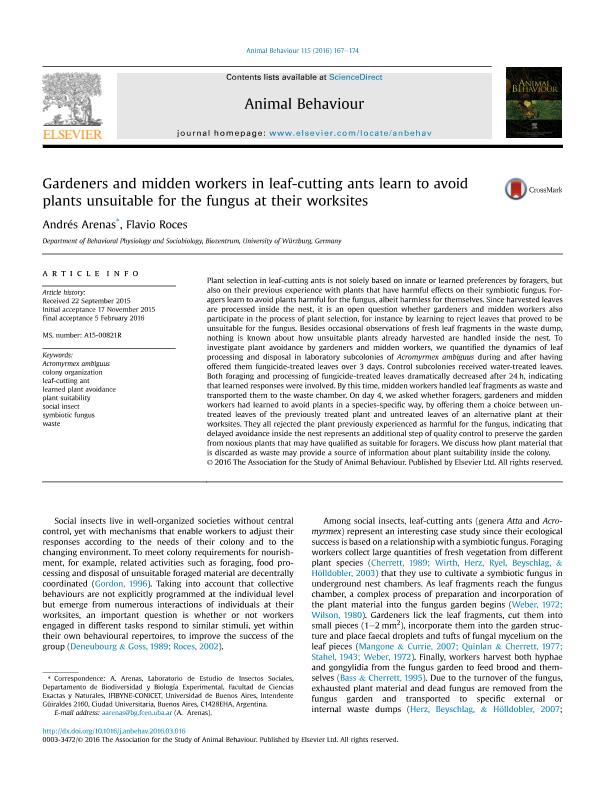Mostrar el registro sencillo del ítem
dc.contributor.author
Arenas, Andres

dc.contributor.author
Roces, Flavio

dc.date.available
2018-05-11T21:11:23Z
dc.date.issued
2016-05
dc.identifier.citation
Arenas, Andres; Roces, Flavio; Gardeners and midden workers in leaf-cutting ants learn to avoid plants unsuitable for the fungus at their worksites; Academic Press Ltd - Elsevier Science Ltd; Animal Behaviour; 115; 5-2016; 167-174
dc.identifier.issn
0003-3472
dc.identifier.uri
http://hdl.handle.net/11336/45000
dc.description.abstract
Plant selection in leaf-cutting ants is not solely based on innate or learned preferences by foragers, but also on their previous experience with plants that have harmful effects on their symbiotic fungus. Foragers learn to avoid plants harmful for the fungus, albeit harmless for themselves. Since harvested leaves are processed inside the nest, it is an open question whether gardeners and midden workers alsoparticipate in the process of plant selection, for instance by learning to reject leaves that proved to be unsuitable for the fungus. Besides occasional observations of fresh leaf fragments in the waste dump, nothing is known about how unsuitable plants already harvested are handled inside the nest. To investigate plant avoidance by gardeners and midden workers, we quantified the dynamics of leaf processing and disposal in laboratory subcolonies of Acromyrmex ambiguus during and after havingoffered them fungicide-treated leaves over 3 days. Control subcolonies received water-treated leaves. Both foraging and processing of fungicide-treated leaves dramatically decreased after 24 h, indicating that learned responses were involved. By this time, midden workers handled leaf fragments as waste and transported them to the waste chamber. On day 4, we asked whether foragers, gardeners and middenworkers had learned to avoid plants in a species-specific way, by offering them a choice between untreated leaves of the previously treated plant and untreated leaves of an alternative plant at their worksites. They all rejected the plant previously experienced as harmful for the fungus, indicating that delayed avoidance inside the nest represents an additional step of quality control to preserve the garden from noxious plants that may have qualified as suitable for foragers. We discuss how plant material that is discarded as waste may provide a source of information about plant suitability inside the colony.
dc.format
application/pdf
dc.language.iso
eng
dc.publisher
Academic Press Ltd - Elsevier Science Ltd

dc.rights
info:eu-repo/semantics/openAccess
dc.rights.uri
https://creativecommons.org/licenses/by-nc-sa/2.5/ar/
dc.subject
Hormigas Cortadoras de Hojas
dc.subject
Aprendizaje de Evitación
dc.subject
Hongo Simbionte
dc.subject.classification
Otras Ciencias Biológicas

dc.subject.classification
Ciencias Biológicas

dc.subject.classification
CIENCIAS NATURALES Y EXACTAS

dc.title
Gardeners and midden workers in leaf-cutting ants learn to avoid plants unsuitable for the fungus at their worksites
dc.type
info:eu-repo/semantics/article
dc.type
info:ar-repo/semantics/artículo
dc.type
info:eu-repo/semantics/publishedVersion
dc.date.updated
2018-05-11T20:54:58Z
dc.journal.volume
115
dc.journal.pagination
167-174
dc.journal.pais
Países Bajos

dc.journal.ciudad
Amsterdam
dc.description.fil
Fil: Arenas, Andres. University of Würzburg; Alemania. Consejo Nacional de Investigaciones Científicas y Técnicas. Oficina de Coordinación Administrativa Ciudad Universitaria. Instituto de Fisiología, Biología Molecular y Neurociencias. Universidad de Buenos Aires. Facultad de Ciencias Exactas y Naturales. Instituto de Fisiología, Biología Molecular y Neurociencias; Argentina
dc.description.fil
Fil: Roces, Flavio. University of Würzburg; Alemania
dc.journal.title
Animal Behaviour

dc.relation.alternativeid
info:eu-repo/semantics/altIdentifier/doi/http://dx.doi.org/10.1016/j.anbehav.2016.03.016
dc.relation.alternativeid
info:eu-repo/semantics/altIdentifier/url/https://www.sciencedirect.com/science/article/pii/S0003347216000919
Archivos asociados
